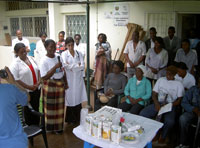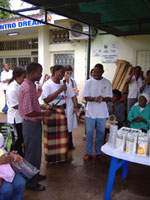|
MOZAMBIQUE:
PARTY AT MACHAVA FOR
DREAM´┐ŻS FOURTH BIRTHDAY
 The fourth anniversary falls right about now ´┐Ż it was on the 28th February
2002, to be precise, that the first DREAM centre for antiretroviral therapy in Africa, the
Machava centre, opened in Maputo, Mozambique.
The fourth anniversary falls right about now ´┐Ż it was on the 28th February
2002, to be precise, that the first DREAM centre for antiretroviral therapy in Africa, the
Machava centre, opened in Maputo, Mozambique.
DREAM, then, completes its fourth year: four years of realising and tending a dream, four years of top quality medical care, freely accessible and cost-free to many in Africa. They have been four years of work and commitment to extending the right to health to that most neglected of
continents, to ensuring that drugs that have saved many lives in the West be put at the disposal of
Africans, too.
To the Community of Sant´┐ŻEgidio,
this right to therapy appeared to be a human right violated,
disregarded, often without so much as the violation being noted as such at the level of our
consciences. Nonetheless, the Community felt itself duty-bound by the silent appeal arising from the sick of many African
countries: from adult men and women, from young people, from a multitude of children.
Here it was, then, this task of planting a tiny seed in
Mozambique, at Machava, on that 28th February 2002: the seed of treating people affected by AIDS on African
soil, a seed to prevent the vertical spread of HIV, to secure the continent´┐Żs future.
 That seed has borne many
fruits. DREAM has grown. To the first Mozambican centre at Machava, many others have been
added. Matola and the Polana Canico, in 2002. Beira, in the centre of the country, and three more Mozambican facilities in 2003. Nampula and
Quelimane, in the same country, in 2004; and then Iringa, also in that
year, the first DREAM centre outside Mozambique, in Tanzania. And then in 2005, also in Tanzania, Arusha and
Usokami; but also, in the same year, the reaching out of our DREAM to many other
countries: to Malawi, with the centre of Lilongwe; to Guinea Bissau, with the centre opened in the capital; to Kenya, with the centre of
Tharaka. Bringing us, now in 2006, to the forthcoming opening of the DREAM centres of
Conakry, in Guinea, of Blantyre, in Malawi, and of Abuja, in Nigeria, and to the joint venture with centres run by religious congregations in the Democratic Republic of Congo and in Angola. That seed has borne many
fruits. DREAM has grown. To the first Mozambican centre at Machava, many others have been
added. Matola and the Polana Canico, in 2002. Beira, in the centre of the country, and three more Mozambican facilities in 2003. Nampula and
Quelimane, in the same country, in 2004; and then Iringa, also in that
year, the first DREAM centre outside Mozambique, in Tanzania. And then in 2005, also in Tanzania, Arusha and
Usokami; but also, in the same year, the reaching out of our DREAM to many other
countries: to Malawi, with the centre of Lilongwe; to Guinea Bissau, with the centre opened in the capital; to Kenya, with the centre of
Tharaka. Bringing us, now in 2006, to the forthcoming opening of the DREAM centres of
Conakry, in Guinea, of Blantyre, in Malawi, and of Abuja, in Nigeria, and to the joint venture with centres run by religious congregations in the Democratic Republic of Congo and in Angola.
The figures for these few, but packed
years, tell the story. The various DREAM centres have tested over 22,000
persons. Their laboratories have processed more than 80,000 blood
samples, including tests for viral load and CD4 count. Our doctors have performed more than 115,000
visits. More than 11,000 patients are receiving treatment at
present, of whom over 5,000 are on anti-retrovirals, a fifth of them
children. There have been 2,200 expecting mothers whose pregnancies have been accompanied by treatment to prevent vertical
transmission: more than 1,500 babies born disease-free. 13 training courses for the staff of the
centres: 12 in Mozambique and one in Tanzania, have contributed to improving the level of professionalism of many African men and
women, participants in the dream of opening this continent to a future that is free from AIDS.
That 28th February four years ago, when all this
began, we commemorated on Friday 3rd March, in Machava itself, with a big party involving
doctors, nurses, activists, health workers on the DREAM program, as well as patients in our care.
In spite of the rain falling at this season, many came to celebrate this important day
together. A lot of women were present, having come from the other large DREAM centre of
Maputo, that of Matola, together with their children, born healthy thanks to the prevention of mother-to-child
transmission.
 One of the first to speak had been among our first
patients, Ana Maria, today in good health and working as an activist in the field of
´┐ŻMulheres para o DREAM´┐Ż. The members of this association bear witness to their own
´┐Żresurrection´┐Ż, people who have received a great gift and who repay it by putting their own experience and their own conviction at the disposal of those who are
sick. Ana Maria wanted to remind us how a lot of people, four years ago, without any hope of finding a way out of their condition of
illness, would never have thought they´┐Żd live to see such a moment of joy all these years
later. One of the first to speak had been among our first
patients, Ana Maria, today in good health and working as an activist in the field of
´┐ŻMulheres para o DREAM´┐Ż. The members of this association bear witness to their own
´┐Żresurrection´┐Ż, people who have received a great gift and who repay it by putting their own experience and their own conviction at the disposal of those who are
sick. Ana Maria wanted to remind us how a lot of people, four years ago, without any hope of finding a way out of their condition of
illness, would never have thought they´┐Żd live to see such a moment of joy all these years
later.
Another, speaking after Ana
Maria, added that, after the 4th October ´┐Ż the day on which the peace accord was signed ending many years of civil war ´┐Ż this date, the
28th February could be considered the most important date in
Mozambique´┐Żs history.
A large cake, spumante, and songs filled with joy brought this day of celebration to its
conclusion, this anniversary of a day which restored life and granted years of life to
many.
|